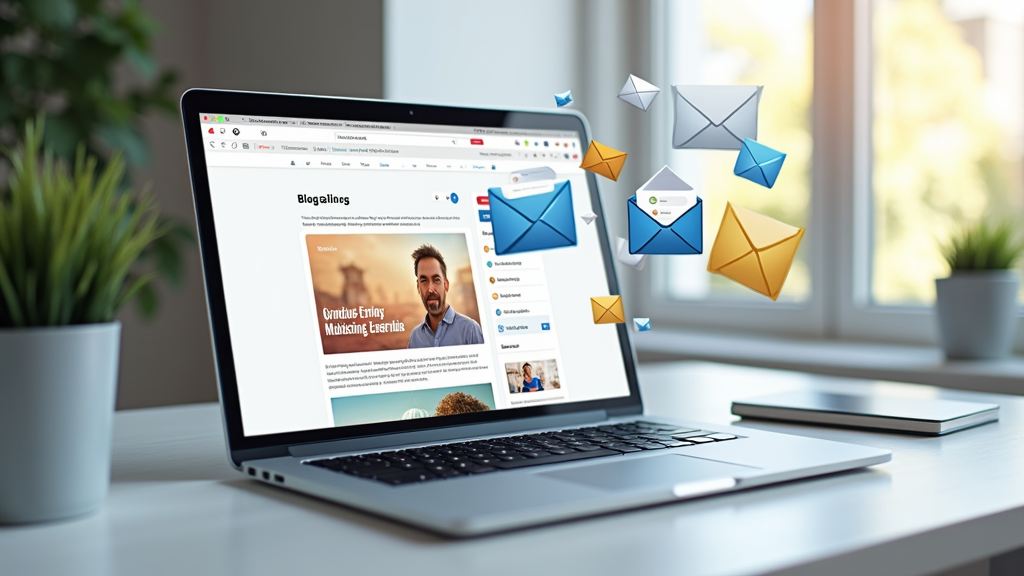Building an email list for your blog isn’t just a side project. It’s probably the most reliable way to boost your blog’s earning power over time. If you’re looking for steady blog income or just want to have a group of loyal readers ready for anything you create, starting and growing an email list is a pretty smart move. In this article, I’m going to share all my tips and and tricks i have picked up in my research on how to get your list up and running, what tools make it easy, and practical ways to start making money from your subscribers. At this moment in time I am also learning and discovering so this is like my folder of screenshots.

Why I’m Finally Taking Email Marketing Seriously (And Why You Should Too)
When I first started blogging, email marketing barely crossed my mind. Social media seemed like the go-to strategy, quick, interactive, and easy to grow. I figured that was enough. Why bother with email when I could post and instantly reach people?
However, after a few missteps, I began to see cracks in that plan. Algorithms kept shifting, engagement dropped, and suddenly, the audience I thought I had wasn’t really mine at all. I’d pour time into crafting posts, only to watch them disappear into the void of whatever trend was taking over that week.
That’s when I began to look at email differently. Unlike social media, email doesn’t rely on unpredictable algorithms. It’s direct, personal, and fully mine, no middleman deciding who gets to see my content. If I offer real value, people will open my emails, engage with them, and maybe even buy from me.
Research indicates that email marketing consistently yields a higher return on investment (ROI) than social media or paid advertising. Whether they are launching a product, sharing affiliate recommendations, or simply sending readers to the latest post, an email list is the one place where you have lasting control.
So, this time around, I’m all in. I’m diving deep into the how of email marketing—figuring out what works, testing strategies, and building a system that feels sustainable. If I could go back and give my past self one piece of advice, it’d be simple: don’t wait. Your email list isn’t just another tool—it’s the foundation of your business.
If you’re in the same boat, trying to navigate email marketing without feeling overwhelmed, let’s do it together. I’ll be sharing my wins, mistakes, and everything I learn along the way.
Getting Started: The Basics of Email List Building
Like most things in blogging, getting started is about setting up the right foundation. Here’s what I have learned so far (and it works for most bloggers):
- Pick an Email Marketing Platform: Select an Email Marketing Platform. Opt for a beginner-friendly tool.
- Create a “Lead Magnet”: Offer readers a freebie in exchange for their email. This could be a checklist, a printable resource guide, or even a short email course. The key is that it helps your audience solve a problem or learn something new. I am offering planners at present.
- Add Signup Forms in the Right Places: Place signup forms in areas where people are likely to see them, such as your blog’s homepage, at the end of posts, or even as pop-ups. Just don’t go overboard and annoy readers.
- Write a Welcome Email: This sets the tone and encourages new subscribers to explore more of your content or follow you on social media.
Simple Strategies to Grow Your Email List
Growing a list will take a bit of patience, but there are ways to give it a decent jumpstart:
Here’s what I’ve learned so far, and what I’m planning to implement
- Create Multiple Lead Magnets I’ve noticed that bloggers who tailor their freebies to specific posts tend to see higher signup rates. It makes sense—offering a spreadsheet template for a finance article or a packing list for travel readers gives people an instant reason to subscribe. I’ll be experimenting with content upgrades that align with my most popular posts.
- Use Social Proof. People trust recommendations, and showing that others are already benefiting from my content is a great way to encourage signups. I’ll highlight subscriber counts (if I’m comfortable) and feature testimonials from engaged readers to help build credibility.
- Promote My Freebie on Social. I’ve seen how powerful social channels can be for growing an email list, especially when you treat them as traffic sources rather than relying solely on them for engagement. I plan to ensure my lead magnets are front and centre, including my Instagram bio, TikTok link, LinkedIn profile, Pinterest, and even collaborations with other bloggers. Joint promotions could be a game-changer for exposure.
- Run a Giveaway. One of the fastest ways to boost email signups is through a giveaway; people love the chance to win something valuable. The key is offering a prize that actually appeals to my audience, not just something flashy. I’ve seen bloggers team up for bigger giveaways, pooling their reach to bring in a wave of new subscribers. Definitely something worth considering.
- Provide Consistent Value. Nobody wants to sign up for emails that sit in their inbox unread. To maintain high engagement, I’ll ensure subscribers understand precisely what they’re getting—exclusive tips, early product launches, behind-the-scenes insights, or any other content that adds genuine value.
- Leverage My Existing Audience. One thing I’ve realised is that the easiest people to convert into email subscribers are those who already enjoy my content.
- A simple blog post, tweet, or Instagram story can remind current followers to sign up, and I’ll be making that part of my regular strategy.
Things You Should Probably Consider Before Building Your List Out
Before diving headfirst into list-building, I’ve realised there are a few things worth considering. Rushing in without a plan can lead to more unsubscribes than sign-ups, and after doing my research, I know I want to set things up properly from the start. Here’s what I’ve learned so far:
Choosing the Right Platform
Switching email providers later is doable, but it’s not ideal, especially when automations, tags, and templates come into play. So, choosing the right platform early is crucial. Some focus on automation, while others prioritise simplicity or cost. From what I’ve seen, ConvertKit, AWeber and MailerLite are great options for beginners, offering free plans, solid support, and easy-to-follow tutorials.
Understanding Privacy and Spam Laws
GDPR and CAN-SPAM regulations require me to be transparent about how I use subscriber information and ensure that people can easily opt out. Most email platforms take care of compliance automatically, but it’s still worth double-checking my privacy policy to ensure everything is clear.
Setting Email Frequency
One thing that keeps cropping up in my research is that consistency is more important than frequency. Whether I send emails weekly, fortnightly, or monthly, setting expectations early will help retain engagement. I’m still deciding on a schedule, but I definitely don’t want to disappear for months or overwhelm people with daily emails. Knowing myself, weekly would be too often for me to keep up, but fortnightly would be a better fit for me.
Quality Over Quantity
A smaller, engaged list is far more valuable than a huge subscriber count where nobody actually reads my emails. The aim isn’t just numbers—it’s building real connections. From what I’ve learned, personal messages, surveys, and direct engagement help keep subscribers interested and loyal.
Ways I Can Monetise My Email List
Once I have an engaged audience, the exciting part begins—turning my email list into a reliable income stream. Based on my research, here are some of the most promising strategies:
- Affiliate Marketing: This appears to be one of the easiest ways to start earning. By recommending products I genuinely use and love, I can include affiliate links in emails (not Amazon associate products, though) and receive commissions when subscribers make a purchase. The key is authenticity; forced promotions don’t convert well.
- Digital Products & Courses: Many bloggers launch eBooks, paid newsletters, and online courses directly through their email lists. Pre-launch specials or exclusive discounts for subscribers make email an excellent sales channel for digital products.
- Sponsored Emails: If I build a large enough audience, brands might pay to be featured in my newsletter. However, it’s crucial to be selective with sponsorships to maintain trust and ensure I’m only promoting high-quality, relevant products.
- Driving Traffic to My Blog: Sending readers to my latest blog posts boosts ad revenue and affiliate sales. Many bloggers utilise their email lists to share new content and maintain high engagement, while earning a passive income through clicks.
- Exclusive Offers & Memberships: Another option is to create a private, subscriber-only community or a paid membership model. Some bloggers eventually move the majority of their income to email-driven products, as email attracts the most loyal followers.
Advanced Strategies to Make the Most of My List
Now that I understand the basics, I’ve explored ways to refine and optimise my email marketing efforts as I grow my list:
- Segmenting My List: Sorting subscribers by interest seems like a smart move. If someone downloads a “keto shopping list,” they’ll likely want recipes, not travel advice. Sending tailored emails based on interests improves open rates and engagement.
- A/B Testing: Many email platforms enable split testing for subject lines, call-to-action (CTA) buttons, and even images. From what I’ve seen, tweaking a subject line can dramatically boost open rates. Experimenting with send times and messaging will be a must.
- Personalisation & Automation: Addressing subscribers by name or referencing something they’ve downloaded makes emails feel more conversational. Automated sequences—like a welcome series—help introduce my best content and create an effortless onboarding experience.
FAQs I’ve Come Across
From all my research, these seem to be the most common questions people ask before starting an email list:
Q: How many subscribers do I need to make money? A: It’s all about engagement, not just numbers. Some bloggers earn a decent income with just a few hundred loyal subscribers, while others need thousands. The key is trust—an engaged audience is far more valuable than a passive one.
Q: What kind of emails should I send? : A mix works best—newsletters, personal updates, exclusive tips, and occasional promotions. Asking subscribers what they want is always a smart approach, and conducting occasional surveys can help refine content.
Q: How often should I send emails? A: Consistency matters more than frequency. Weekly, fortnightly, or monthly schedules all work, as long as you stick to a steady rhythm. Disappearing for long periods or bombarding people with constant emails can hurt engagement.
Final Thoughts
The more I research email marketing, the more I see how valuable it is—not just as a way to connect with readers, but as a dependable income stream. I haven’t implemented all of this yet, but I know that building my email list will be an essential part of my strategy moving forward. The best time to start is now, and I’m ready to take the next step.
💬 Let’s chat! If you’ve dabbled in email marketing, what’s worked for you? Do you have any strategies, tools, or lessons learned? Or if you’re starting out, what’s your biggest question? Drop a comment, I’d love to swap ideas and figure this out together!
